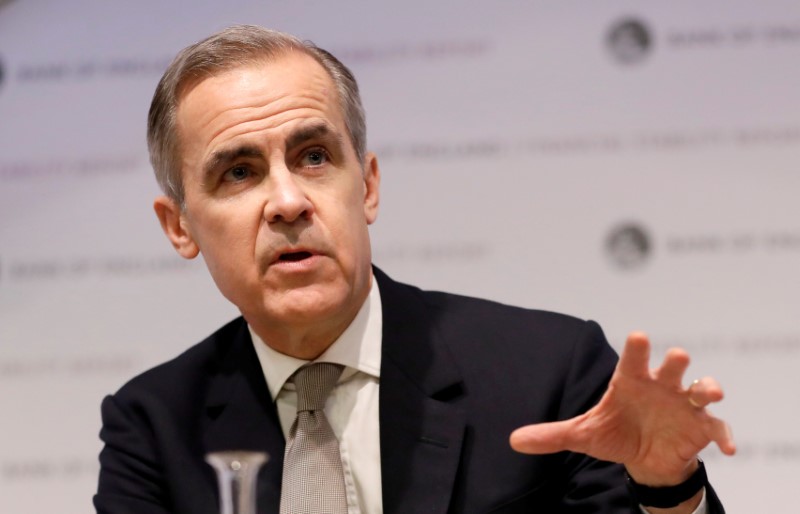By Sujata Rao and Ritvik Carvalho
LONDON (Reuters) - The swift repricing of short-dated UK interest rate futures has sent bond yields plunging but barely moved sterling, which is still holding out hopes of a post-election, post-Brexit inward investment bounce that will lift the pound in time.
On Jan. 9, money markets saw just a 20% chance of an interest rate cut this month. But by Jan. 17, dismal UK growth and inflation readings from late 2019 and a series of speeches from Bank of England chief Mark Carney and at least three of his policymaking colleagues pushed those easing expectations to 70%.
(Graphic: UK economic growth weakest since 2012 in November: https://fingfx.thomsonreuters.com/gfx/mkt/13/1283/1269/UKecon.png)
(Graphic: Money markets price UK interest rate cut: https://fingfx.thomsonreuters.com/gfx/mkt/13/1287/1273/moneymarket.png)
Gilt markets responded with a roughly 25 basis point fall in yields. But sterling, which would typically weaken on the prospect of lower rates, slipped by less than 1%.
"We do not often see such a dichotomy between gilts and sterling," said Neil Jones, head of hedge fund sales at Mizuho. "The explanation would lie in the gilt market focusing heavily upon interest rate expectations while the pound ... is also looking at other factors such as longer-term investor inflows."
Bullish sterling bets rose to 21-month highs in the week to Jan. 14, according to the U.S. Commodity Futures Trading Commission, and speculators are now substantially net 'long' of pounds.
Derivatives markets also show little sign of worry -- for the first time since October, there's an implied volatility premium to buy one-month sterling 'calls' over puts -- options conferring the right to buy and sell, respectively.
(Graphic: Sterling risk reversals: https://fingfx.thomsonreuters.com/gfx/mkt/13/1314/1300/riskreversals.png)
Sterling remains sensitive to developments following Brexit on Jan. 31, however, while Carney's replacement as central bank governor by Andrew Bailey next month is another source of potential uncertainty.
The pound relapsed below $1.30 on Monday after comments by finance minister Sajid Javid revived fears that Britain and the European Union will not have agreed a trade deal before the post-Brexit transition period expires at year-end. It has recovered since.
Investors have mostly shunned Britain since the 2016 referendum vote to leave the EU, pulling around $30 billion from UK shares, according to EPFR data, while firms borrowing on bond markets have been saddled with a 'Brexit premium'.
Direct investment from abroad dropped 6% last year, United Nations data showed on Monday, after a 36% plunge in 2018.
But relief that Brexit is happening with a political agreement in place and commitment to talks on a trade deal is encouraging hopes of some rebalancing toward UK assets within international portfolios.
A rate cut would lift those assets further, offsetting the impact on sterling.
What's more, the March 11 budget should bring some big fiscal stimulus. The government has pledged the largest public services spending increases in 15 years, with plans to spend 3% of annual output on infrastructure, almost double historical averages.
"Even if the BOE cuts rates, fiscal policy will be supportive and that suggests upside for sterling," said Sarah Hewin, chief Europe economist at Standard Chartered (LON:STAN), who expects the BOE to cut next week then stop.
She noted that the data which drove the money market shift -- growth, inflation and retail sales -- were from before Dec. 12's election, so would not reflect the upticks registered by some post-election surveys on business confidence and housing.
Flash January Purchasing Managers' Index (PMI) readings on Friday will be the first significant indicator of business sentiment after the election.
"The broader theme is yes, the BoE may cut but this ought to be enough to allow the economy to stabilise," Hewin added.
Some argue that gilts reacted to a clearly dovish signal from policymakers who had until now mostly implied rates could move either way. That left short-dated yields more or less tracking the 0.75% Bank Rate, said Marc Ostwald, global strategist at ADM Investor Services.
"The adjustment in the gilt curve is all about having somewhat greater clarity on where rates are likely to go over the next six to 12 months," Ostwald said.
Sterling has meanwhile been the main Brexit barometer, he said, with the possibility of crashing out of the EU keeping the currency languishing well off pre-referendum levels of $1.50.
On a "real" basis too -- against the currencies of Britain's trade partners -- sterling remains below its long-term average. Fair value is around $1.40, Hewin reckons.
(Graphic: Sterling cheap on a historical basis: https://fingfx.thomsonreuters.com/gfx/mkt/13/1290/1276/valuations.png)
Of course, the build-up in 'long' positions makes sterling vulnerable should data, BOE signals or trade headlines disappoint.
UK economic surprises, reflected by a Citi index, are already the most negative since August, contrasting with positive momentum almost everywhere else.
(Graphic: UK remains outlier in economic surprises rebound: https://fingfx.thomsonreuters.com/gfx/mkt/13/1285/1271/econsurprises.png)
Ned Rumpeltin at TD Securities expects a sober reassessment to dull sterling's election-led cheer.

"While we are quick to note that the relationship between rates and currency has diminished greatly in recent months, we do not think sterling can completely ignore the BoE's monetary policy cues for much longer," he told clients.